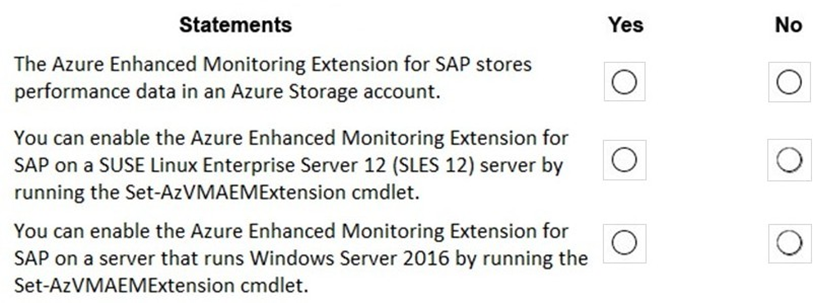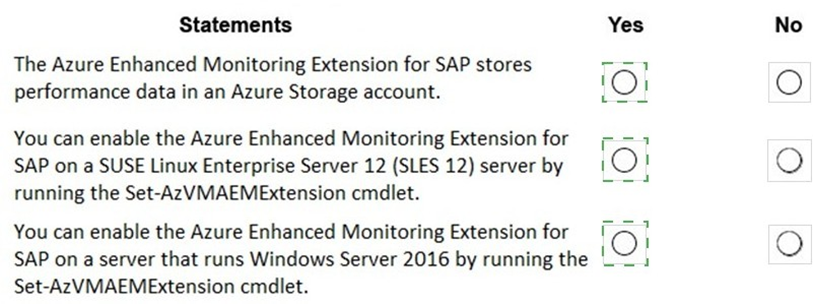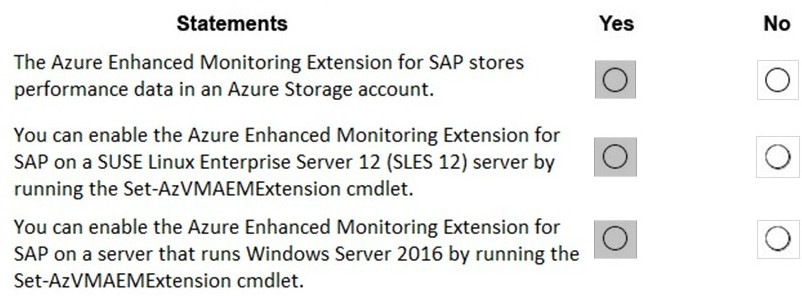
- Email support@dumps4free.com

Topic 2: Misc. Questions
You deploy an SAP environment on Azure by following the SAP workload on Azure planning and deployment checklist.
You need to verify whether Azure Diagnostics is enabled. Which cmdlet should you run?
A.
Get-AzureVMAvailableExtension
B.
Get-AzVmDiagnosticsExtension
C.
Test-AzDeployment
D.
Test-VMConfigForSAP
Get-AzVmDiagnosticsExtension
Explanation:
The Get-AzVMDiagnosticsExtension cmdlet gets the settings of the Azure Diagnostics extension on a virtual machine.
For each of the following statements, select Yes if the statement is true. Otherwise, select No. NOTE Each correct selection is worth one point.

Answer:

Explanation:

For each of the following statements, select Yes if the statement is true. Otherwise, select No. NOTE: Each correct selection is worth one point.

Answer:

Explanation:

You plan to migrate an SAP HANA instance to Azure. You need to gather CPU metrics from the last 24 hours from the instance. Solution: You run SAP HANA Quick Sizer.Does this meet the goal?
A.
Yes
B.
No
No
Explanation:
The SAP HANA cockpit provides a single point of access to a range of SAP HANA administration and monitoring tasks. It is used to monitor and ensure the overall health of the system.
The HANA Monitoring dashboard also visualizes key HANA Metrics of SAP HANA system.
You have an Azure subscription. Your company has an SAP environment that runs on SUSE Linux Enterprise Server (SLES) servers and SAP HANA. The environment has a primary site and a disaster recovery site. Disaster recovery is based on SAP HANA system replication. The SAP ERP environment is 4 TB and has a projected growth of 5% per month.
The company has an uptime Service Level Agreement (SLA) of 99.99%, a maximum recovery time objective (RTO) of four hours, and a recovery point objective (RPO) of 10 minutes. You plan to migrate to Azure. You need to design an SAP landscape for the company. Which options meet the company’s requirements?
A.
Azure virtual machines and SLES for SAP application servers SAP HANA on Azure (Large Instances) that uses SAP HANA system replication for high availability and disaster recovery
B.
ASCS/ERS and SLES clustering that uses the Pacemaker fence agent SAP application servers deployed to an Azure Availability Zone SAP HANA on Azure (Large Instances) that uses SAP HANA system replication for database high
availability and disaster recovery
C.
SAP application instances deployed to an Azure Availability Set SAP HANA on Azure (Large Instances) that uses SAP HANA system replication for database high availability and disaster recovery
D.
ASCS/ERS and SLES clustering that uses the Azure fence agent SAP application servers deployed to an Azure Availability Set SAP HANA on Azure (Large Instances) that uses SAP HANA system replication for database high
availability and disaster recovery
ASCS/ERS and SLES clustering that uses the Pacemaker fence agent SAP application servers deployed to an Azure Availability Zone SAP HANA on Azure (Large Instances) that uses SAP HANA system replication for database high
availability and disaster recovery
Explanation:
With Availability Zones, Azure offers industry best 99.99% VM uptime SLA.
| Page 10 out of 44 Pages |
| Previous |